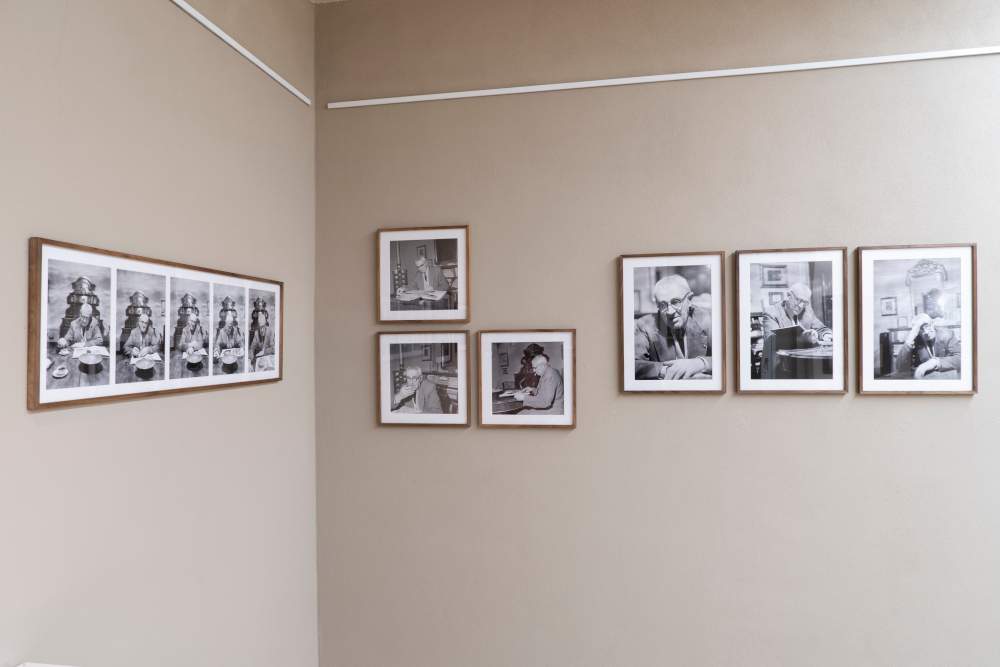Opening on Thursday, November 24, 2022 at 6 p.m. at Casa Morandi, in the spaces of what was once the home-studio of the Bolognese master, the photographic exhibition L’“Epoca” by Mario De Biasi. Morandi through the Lens, curated by Lorenza Selleri and Silvia De Biasi, daughter of the photographer and head of her father’s Archive, and open to the public until Feb. 5, 2023. The exhibition will present a series of non-posed portraits of Giorgio Morandi in his home environment, taken in 1959 by Mario De Biasi, then a photojournalist for Epoca.
In April 1959 Mario De Biasi was sent by Enzo Biagi, the young editor of Epoca magazine, to Via Fondazza 36 to make a reportage on Giorgio Morandi. Despite his shy nature, the artist agreed to be photographed within the walls of his home, in the living room where guests were welcomed, strictly in a suit and tie.
His shots show a non-posed Morandi, who does not assume unnatural or forced attitudes, fitting perfectly into a genre that De Biasi had already experimented with, that of portraits of famous people caught in their everyday life. De Biasi had even coined for this genre of shots the term “portraits in shirtsleeves.”
We thus witness situations of domestic routine, between books to leaf through, the ever-present cigarette between his fingers and the coffee served by his sister Maria Teresa, who manages to wring a rare smile from the always composed and austere Morandi. The selection of volumes the master chose to leaf through during De Biasi’s visit is interesting: on the table can be seen German art historian Grete Ring’s most important work, A century of French painting 1400-1500, in which Morandi dwells on Henri Bellechose’s Trinity and Stories of St. Dionysius, as well as on the details of Nicolas Froment’s Triptych with the Resurrection of Lazarus. Also, probably to find common ground with the photographer in front of him, on the table is Henri Cartier Bresson’s monograph, Images à la Sauvette, a gift that Michelangelo Antonioni sent to Morandi a few days earlier.
De Biasi did not, like no other photographer, have the opportunity to portray Morandi at work in the studio, in the act of painting, nor was he allowed to include in his shots the easel, brushes, palette, colors and objects of the painter’s artistic activity. The photographs do, however, offer a vivid glimpse of a room in the house on Via Fondazza, of the arrangement of furniture, furnishings and paintings as positioned and experienced at the time.
Alongside the nineteen photographs taken in Bologna in Morandi’s home, the public will be able to see in the exhibition five other portraits taken by De Biasi in Milan, in which the Bolognese master is present thanks to his own works: three of these show Lamberto Vitali in his apartment, surrounded by as many as fourteen paintings by Morandi, and two others have as their subject Elio Vittorini, intent on reading and writing in his studio, where a still life by Morandi, without a frame, dated 1949, can be glimpsed.
The exhibition is accompanied by documents, original issues of the weekly magazine Epoca from the museum’s archives and the Library of the Istituto Storico Parri, books from the artist’s personal library and a video interview with Mario De Biasi made by Laura Leonelli in 2005.
In collaboration with Mario De Biasi Archive.
Hours: Saturday from 2 to 5 p.m.; Sunday from 10 a.m. to 1 p.m. and 2 to 5 p.m. Friday, Nov. 25, 2022 special opening from 2 to 5 p.m.
Free admission. Online reservation https://www.midaticket.it/eventi/casa-morandi
For info: www.mambo-bologna.org/museomorandi/
Photo by Ornella De Carlo
Courtesy of Settore Musei Civici Bologna | Casa Morandi
 |
| At Casa Morandi, De Biasi's shots that tell the story of Giorgio Morandi within the domestic walls |
Warning: the translation into English of the original Italian article was created using automatic tools. We undertake to review all articles, but we do not guarantee the total absence of inaccuracies in the translation due to the program. You can find the original by clicking on the ITA button. If you find any mistake,please contact us.